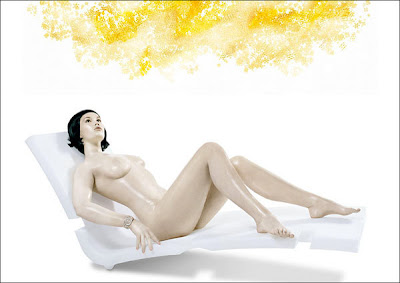 Andre Zucca's photographs of gay Paris at war paint an uneasy portrait of city collaboration From The Times April 18, 2008
Andre Zucca's photographs of gay Paris at war paint an uneasy portrait of city collaboration From The Times April 18, 2008Charles Bremner in Paris
An unusual warning has been added to a Paris exhibition that has shocked some visitors and media, despite the absence of sex, violence or religion.
The photographic show has caused offence by depicting the French capital in the Second World War as a sunny place, where people enjoyed life alongside their Nazi occupiers.
Bertrand Delanoë, the Mayor, ordered a notice, in French and English, to be handed out at the door of the municipal exhibition of colour photographs that have stirred ghosts that Paris preferred to forget. The 270 never-published pictures avoid the “reality of occupation and its tragic aspects”, says the warning.
 In the French collective memory, early 1940s Paris was a black-and-white hell of hunger, Nazi round-ups, humiliation and resistance. Films and books have in recent decades modified the cliché. The breathtaking colour series by André Zucca, a French photographer, show as never before a gay Paris that got on with life without great hardship.
In the French collective memory, early 1940s Paris was a black-and-white hell of hunger, Nazi round-ups, humiliation and resistance. Films and books have in recent decades modified the cliché. The breathtaking colour series by André Zucca, a French photographer, show as never before a gay Paris that got on with life without great hardship.Well-dressed citizens shop on the boulevards and stroll in the parks; young people crowd nightclubs; bikini-clad women bathe in the fashionable Deligny pool. The terraces of familiar cafés are crowded and commuters with briefcases march into the Métro.
The differences are the absent traffic, the Wehrmacht uniforms and red swastikas hanging from the grandest facades. In one sinister picture – taken in the street beside the gallery – an old woman wears a yellow Star of David, the insignia that Jews were forced to display. According to critics, the organisers at the Paris Historical Library neglected to make it clear that Zucca, a respected prewar photographer, was working for the German propaganda machine.
 Pierre Assouline, a writer, said in Le Monde: “In the shadows of these same streets, they were dying of hunger and cold. Raids and torture were taking place. Here we see only relaxation, joie de vivre, the nonchalance of a kind of happiness.” Christophe Girard, the deputy mayor in charge of culture, said that he found the exhibition “em-barrassing, ambiguous and poorly explained”.
Pierre Assouline, a writer, said in Le Monde: “In the shadows of these same streets, they were dying of hunger and cold. Raids and torture were taking place. Here we see only relaxation, joie de vivre, the nonchalance of a kind of happiness.” Christophe Girard, the deputy mayor in charge of culture, said that he found the exhibition “em-barrassing, ambiguous and poorly explained”.Jean Derens, the director of the library, rejected the criticism, saying that everyone knew the photographer was a collaborator: “If there is a visitor who is unaware of the nature of the occupation, it’s sad, but that does not mean that everything has to be reexplained every time.” He said that the critics were not content with his leaflet, which states: “Zucca portrays a casual, even carefree Paris. He has opted for a vision that does not show . . . the queues . . . the rounding-up of Jews, posters announcing executions.” The library praises the skill of Zucca, “who played on colours like an aesthete” and chronicled the occupation privately, using rare Agfacolor film supplied by the Wehrmacht. The sunny aspect of the photos stemmed from the need to shoot the early colour film in bright light, it adds.
 The exhibition reminds viewers that Paris was relatively comfortable under the Nazis because Joseph Goebbels, Hitler’s propaganda chief, decreed that the capital should be “animated and gay” to show off the “new Europe”. Theatres and cinemas were kept busy; Edith Piaf sang, and Herbert von Karajan conducted.
The exhibition reminds viewers that Paris was relatively comfortable under the Nazis because Joseph Goebbels, Hitler’s propaganda chief, decreed that the capital should be “animated and gay” to show off the “new Europe”. Theatres and cinemas were kept busy; Edith Piaf sang, and Herbert von Karajan conducted.The collection, restored to the original colour with digital techniques, was bought by the city from Zucca’s family in 1985. The photographer was arrested after the 1944 liberation but never prosecuted. He worked until his death in 1976 under an assumed name as a wedding photographer west of Paris.
 — The exhibition is open every day except Mondays, 11am to 7pm, at the Bibliotheque Historique de la Ville de Paris. Lees meer ...
— The exhibition is open every day except Mondays, 11am to 7pm, at the Bibliotheque Historique de la Ville de Paris. Lees meer ...















































